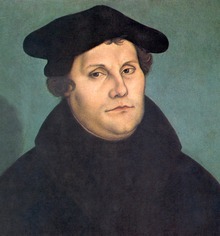Conflicting Religious Perspectives (1517 - 1558)
Chapter 3 : Lutheran Perspective

The German Augustine and priest Martin Luther came to a radically different understanding of the New Testament, particularly after studying the original Greek text. His resulting 95 theses were critical of some Catholic practices, including the selling of indulgences which guaranteed departed souls spent less time in purgatory. Luther is said to have triggered the Reformation in 1517 when, he dramatically nailed his theses to the door.
In 1521, the Church excommunicated Luther, after he refused to recant his ideas at the Diet of Worms. However, he continued his studies in hiding, producing further expositions of New Testament text and a German translation of the Bible.
The new Protestant ideas spread quickly, enabled by the printing press. They were attractive to those already sceptical about Catholic power, wealth and/or inflexibility, including princes and other rulers of the German states which formed the northern part of the Holy Roman Empire.
Church Authority
Behind Martin Luther’s critique of indulgences and other contemporary beliefs and practices, lay the revolutionary assumption that the Bible was the ultimate authority in Christian matters, rather than the Church.
Lutheran Churches were established in each Protestant state, providing spiritual authority alongside the civil rulers. Each Church was governed by a hierarchy of bishops and priests, but now these honoured Luther’s biblical understanding of the Christian faith. Also, individuals were encouraged to read and study the Bible in their own languages.
By 1558, when Queen Elizabeth came to the throne, there were Lutheran Churches in Denmark, Sweden, Norway, and several north German states.
Beliefs and Practices
Although Lutheran Churches maintained infant baptism and the eucharist, their beliefs were primarily confessional rather than sacramental. Protestant leaders met at Augsburg in 1530 to agree 29 articles of faith.
Article 5 of the Augsburg Confession defined Luther’s biggest divergence from Catholic theology, drawn from the New Testament letter to the Romans:
For I am not ashamed of the gospel; it is the power of God for salvation for everyone who has faith ... For in it the righteousness of God is revealed through faith for faith, as it is written. The one who is righteous will live by faith. (Romans 1 v 16-17)
Individuals could not attain right relationship with God (justification) through their own actions, such as performing sacraments or other good works. God’s grace had already provided the means through Jesus’ death on the cross. Individuals needed to respond to this in repentance and faith instead.
This fundamental belief is often called Evangelical, from the Greek word evangel meaning gospel, but Luther also believed that God pre-destined those who will respond in faith.
Lutheran services still included ceremony and liturgy, but with more emphasis on preaching and teaching. During the eucharist service, the bread and wine took on a special mystical significance, but were not changed in substance as per the Catholic tradition. Also, clergy were allowed to marry.
